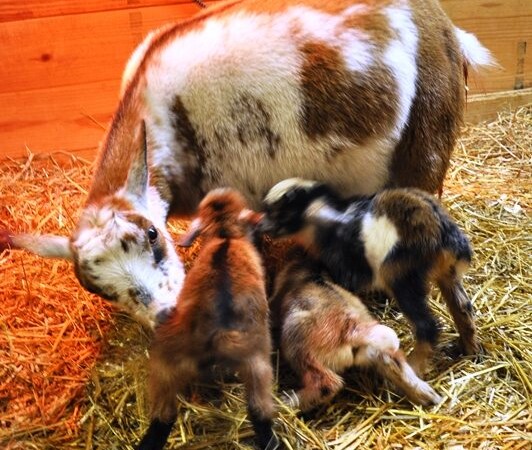

If goats are housed so that they can get out of the wind and stay dry (and they’re receiving adequate nutrition and health care), then they generally tolerate temperatures that are cold without issue.
Even in the coldest areas of the country, goats can tolerate the cold temperatures if they’re dry and protected from the wind.
In the cold, Nigerian Dwarf goats grow a nice undercoat of cashmere that helps to keep them warm. The fluffy cashmere fibers puff out to surround them (that’s why they look so fuzzy in the cold) and keep warm air trapped around their bodies. As long as they can keep that protective layer around them (and it’s not wet or has wind cutting through it), then they can tolerate cold temperatures. One way to think about it is if you can bundle up sufficiently to tolerate the temperature where you’re housing them; then they should be able to tolerate it with their protection.
One thing that all goats do seem to enjoy in cold weather is warm drinking water. You will be quite shocked by how much they prefer the warm water, how big a drink they’ll take, and how warm (hot) they actually like it.
For those farmers keeping bucks and wethers, it’s important to remember that keeping lots of water moving through their systems helps prevent urinary calculi – so providing them with warm water is important not just because they like it, but because it also keeps them healthy.
Goat babies are a different story. Goat kids are born wet and don’t have that dry protective layer. If temperatures are close to or below freezing, Goat owners really need to be present when the babies are born to get them dried off quickly. Otherwise, the babies (or some part of the babies) freeze.
When does are due to kid during cold weather, in addition to being present to help get the kids dried off quickly, many goat owners use heat lamps to keep the kids warm. However, heat lamps are also the number 1 cause of barn fires, so if using heat lamps, it’s critical to use sturdy models built for barn usage and use them correctly. An alternative to heat lamps is to either make goat kid coats or provide the kids with huts to warm up in.
Goat Does that are kidding are also less resistant to cold. Its observed that the rigors of kidding in cold weather often cause Does to shiver badly – it’s just a lot of work and sometimes they don’t have the energy reserves left after kidding to keep themselves warm.
Goats will appreciate the heat lamps you put in place for the kids, a nutritious-warm post-kidding meal, drinks of warm water, and some kind of covering (dry towel, blanket, or old sweatshirt). With a little special “after-kidding” care they return to normal quickly and are great mothers.
 Contact Jaguza Support
Contact Jaguza Support